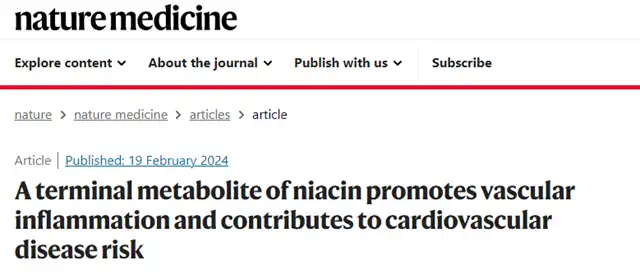Common Vitamin Linked to Increased Risk of Heart Disease
- Normal Liver Cells Found to Promote Cancer Metastasis to the Liver
- Nearly 80% Complete Remission: Breakthrough in ADC Anti-Tumor Treatment
- Vaccination Against Common Diseases May Prevent Dementia!
- New Alzheimer’s Disease (AD) Diagnosis and Staging Criteria
- Breakthrough in Alzheimer’s Disease: New Nasal Spray Halts Cognitive Decline by Targeting Toxic Protein
- Can the Tap Water at the Paris Olympics be Drunk Directly?
Common Vitamin Linked to Increased Risk of Heart Disease
- Should China be held legally responsible for the US’s $18 trillion COVID losses?
- CT Radiation Exposure Linked to Blood Cancer in Children and Adolescents
- FDA has mandated a top-level black box warning for all marketed CAR-T therapies
- Can people with high blood pressure eat peanuts?
- What is the difference between dopamine and dobutamine?
- How long can the patient live after heart stent surgery?
Common Vitamin Linked to Increased Risk of Heart Disease
Cardiovascular disease (CVD) is the leading cause of death globally and also the top cause of death in our country. According to the World Health Organization, nearly 18 million people die from cardiovascular disease each year, accounting for over 30% of global deaths. The high mortality and morbidity rates of cardiovascular disease make it a pressing global public health issue that needs to be addressed.
Vitamin B3, also known as niacin, is a water-soluble vitamin that plays various important physiological roles in the human body. Early studies have shown that vitamin B3 is involved in energy metabolism, promotes skin cell turnover, and has some antioxidant effects. Although niacin is an essential micronutrient, its role in CVD is not yet clear.
On February 19, 2024, researchers at the Cleveland Clinic in the United States published a study in the journal “Nature Medicine” titled “A terminal metabolite of niacin promotes vascular inflammation and contributes to cardiovascular disease risk.”
The study found that excessive intake of vitamin B3 may increase the risk of cardiovascular disease, with higher levels of the niacin metabolite 4PY being closely associated with heart attacks, strokes, and other adverse cardiac events.

Preclinical studies have indicated that 4PY can directly induce vascular inflammation, leading to vascular damage over time and contributing to atherosclerosis.
In this study, researchers used a non-targeted metabolomics approach to identify new metabolites and pathways related to CVD risk, independent of traditional risk factors, that could predict the risk of CVD events using circulating small molecules.
Recent clinical trials have shown that while niacin can lower LDL cholesterol, when used in conjunction with high-potency statin therapy, niacin not only failed to reduce CVD risk but also increased overall mortality, leading to the “niacin paradox.” It has been recognized that niacin has a more complex impact on CVD events, likely through mechanisms independent of cholesterol.
In a prospective discovery cohort of stable participants undergoing selective cardiac diagnostic assessment, a total of 1162 participants were included. Fasting plasma non-targeted metabolomics analysis revealed that niacin metabolism was associated with major adverse cardiovascular events, and higher serum levels of the ultimate niacin metabolites N1-methyl-2-pyridone-5-carboxamide (2PY) and N1-methyl-4-pyridone-3-carboxamide (4PY) were associated with an increased risk of major adverse cardiovascular events over three years.
In two independent clinical validation cohorts, a total of 2331 participants from the United States and 832 participants from Europe were included. Higher circulating levels of 2PY were associated with a 1.64-fold and 2.02-fold increase in the risk of major adverse cardiovascular events, respectively, and higher circulating levels of 4PY were associated with a 1.89-fold and 1.99-fold increase in the risk of major adverse cardiovascular events, respectively.
Furthermore, researchers analyzed the genetic determinants of circulating 2PY and 4PY and found that the ACMSD gene regulates levels of 2PY and 4PY in humans and mice.
Finally, researchers conducted a series of in vitro and in vivo functional experiments, which indicated that 4PY could directly induce vascular inflammation in mice, leading to vascular damage over time and contributing to atherosclerosis.
The researchers metaphorically described our intake of niacin as pouring water from multiple taps into a bucket; once the bucket is full, it starts to overflow. The body then needs to process the overflow and produce other metabolites, including 4PY.
The researchers stated that these findings are exciting because this pathway appears to be a previously unrecognized factor with significant implications for the development of cardiovascular disease. Importantly, we can measure it, which means there is potential for diagnostic tests.
The authors of the study pointed out that this research helps explain the niacin paradox and that long-term studies are needed to assess the impact of chronically elevated 4PY levels on atherosclerosis and other phenotypes.
In conclusion, the study suggests that the ultimate metabolite of excessive niacin, especially 4PY, is associated with the risk of major adverse cardiovascular events and may be mechanistically related to CVD risk through the inflammatory pathway, laying the groundwork for potential new interventions and treatments to reduce or prevent inflammation.
Common Vitamin Linked to Increased Risk of Heart Disease
(source:internet, reference only)
Disclaimer of medicaltrend.org
Important Note: The information provided is for informational purposes only and should not be considered as medical advice.



